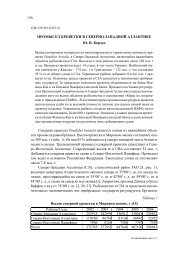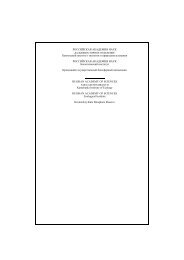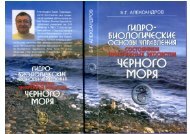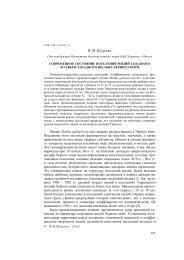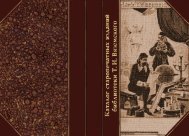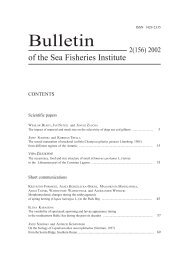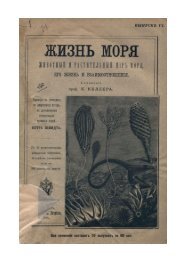Bulletin of the Sea Fisheries Institute 2 (153) 2001 - CEEMaR
Bulletin of the Sea Fisheries Institute 2 (153) 2001 - CEEMaR
Bulletin of the Sea Fisheries Institute 2 (153) 2001 - CEEMaR
You also want an ePaper? Increase the reach of your titles
YUMPU automatically turns print PDFs into web optimized ePapers that Google loves.
Main phytoplankton assemblages ... 39<br />
<strong>the</strong> dominant phytoplankton species. Also, <strong>the</strong> maximum phytoplankton biovolume values were<br />
observed at <strong>the</strong>se stations in each cruise. Samples from <strong>the</strong> vicinity <strong>of</strong> <strong>the</strong> Vistula River at a<br />
similarity level <strong>of</strong> 47% were divided into two groups. The second group included only one<br />
sample from April 1994 which was characterized by a clear domination <strong>of</strong> diatoms and a low<br />
PIE value (0.39), and <strong>the</strong> third group, which consisted <strong>of</strong> samples from July and November<br />
1994 and one sample from July 1996. The phytoplankton composition in both July samples<br />
was characterized by high species diversity (0.71-0.73), while, <strong>the</strong> PIE observed in November<br />
was <strong>the</strong> same as <strong>the</strong> value <strong>of</strong> <strong>the</strong> index obtained in <strong>the</strong> second group.<br />
The next two divisions (at similarity levels <strong>of</strong> 31 and 32%) split <strong>the</strong> remaining samples<br />
from both basins into three sections which correspond approximately to <strong>the</strong> different seasons<br />
<strong>of</strong> <strong>the</strong> vegetation cycle. One consists <strong>of</strong> <strong>the</strong> winter and spring samples, <strong>the</strong> second <strong>of</strong> autumn<br />
samples, and <strong>the</strong> third <strong>of</strong> summer samples.<br />
A high percentage <strong>of</strong> din<strong>of</strong>lagellates Peridiniella catenata, ciliate Mesodinium rubrum<br />
(with autotrophic endosymbionts) and Cryptophyceae in <strong>the</strong> phytoplankton biovolume and a<br />
low PIE index value (median 0.64-0.69) is characteristic <strong>of</strong> <strong>the</strong> samples from <strong>the</strong> winter-spring<br />
section. Samples from <strong>the</strong> winter-spring section were divided , at a similarity level <strong>of</strong> 43%, into<br />
groups four and five. The fourth group consists <strong>of</strong> samples from <strong>the</strong> cruise in <strong>the</strong> first half <strong>of</strong><br />
May 1997 in <strong>the</strong> Gulf <strong>of</strong> Gdañsk to which P. catenata made <strong>the</strong> highest percentage contribution<br />
(on average 34.7%) to <strong>the</strong> biovolume, followed by M. rubrum and Cryptophyceae. O<strong>the</strong>r characteristic<br />
species included nanoplanktonic flagellats, green-algae <strong>of</strong> <strong>the</strong> genus Pyramimonas<br />
and a din<strong>of</strong>lagellate Heterocapsa rotundata. In <strong>the</strong> fifth group, with samples from <strong>the</strong> cruises<br />
which were carried out in ebruary 1996 and April 1994 in <strong>the</strong> Gulf <strong>of</strong> Gdañsk and in March<br />
1996 in <strong>the</strong> Pomeranian Bay, <strong>the</strong> diatoms Centrales, mainly Thalassiosira spp. (on average<br />
43.5%), <strong>the</strong>n P. catenata, M. rubrum and Cryptophyceae were dominant. In addition to <strong>the</strong><br />
above taxa, characteristic species <strong>of</strong> o<strong>the</strong>r diatom representatives were observed, such as<br />
Skeletonema costatum and Chaetoceros spp.<br />
Group six was comprised <strong>of</strong> samples from <strong>the</strong> autumn section. This group consisted <strong>of</strong><br />
samples from <strong>the</strong> November 1994 cruise in <strong>the</strong> Gulf <strong>of</strong> Gdañsk and <strong>the</strong> October 1997 cruise in<br />
<strong>the</strong> Pomeranian Bay. During both cruises, at low species diversity index (median <strong>of</strong> about 0.38)<br />
values, <strong>the</strong> phytoplankton was characterized by <strong>the</strong> domination <strong>of</strong> large Centrales diatoms,<br />
such as: Coscinodiscus granii (on average 73.2%) and Actinocyclus octonarius (on average<br />
7.3%). A high percentage in <strong>the</strong> phytoplankton biovolume was also characteristic for<br />
Cryptophyceae and Mesodinium rubrum.<br />
The third, summer section was divided into four groups, from <strong>the</strong> seventh to <strong>the</strong> tenth. All<br />
<strong>of</strong> <strong>the</strong>m were characterized by <strong>the</strong> high biovolume percentage <strong>of</strong> nanoplanktonic species that<br />
belong to undetermined monade and coccal forms, Cryptophyceae and coccal blue-green algae,<br />
and maximum values <strong>of</strong> <strong>the</strong> PIE index (median about 0.77-0.85) with <strong>the</strong> exception <strong>of</strong> <strong>the</strong><br />
seventh group. The seventh group, with a low PIE index (0.36), contained one sample from <strong>the</strong><br />
Gulf <strong>of</strong> Gdañsk; it was collected in July 1996 at station 63 located in <strong>the</strong> coastal area near <strong>the</strong><br />
Dead Vistula mouth. The din<strong>of</strong>lagellate Heterocapsa triquetra (79.5%) dominated here. This<br />
group was separated from its parent cruise and put closer to <strong>the</strong> eighth group due to its greater<br />
contribution <strong>of</strong> blue-green algae Aphanizomenon sp. and Aphano<strong>the</strong>coideae too. The eighth<br />
group consisted <strong>of</strong> samples from two cruises in <strong>the</strong> Gulf <strong>of</strong> Gdañsk in July 1994 and August<br />
1995 when <strong>the</strong>re were real summer temperatures ranging from 16.6 to 23.9 o C. Blue-green<br />
algae, mainly from <strong>the</strong> subfamily Aphano<strong>the</strong>coideae (on average 14.9%), Aphanizomenon sp.<br />
(on average 11.2%), Nodularia spumigena (on average 10.9%) and Gomphosphaerioideae,<br />
dominated here. The ninth group, separated from group ten at a similarity level <strong>of</strong> nearly 50%,



